Have you ever wondered how to turn your roof into a powerhouse of energy while elevating your home’s style? Solar panel roof designs are becoming increasingly popular because they offer a perfect blend of sustainability and aesthetic appeal. From sleek, modern lines to artistic patterns, innovative design ideas make solar energy more integrated, less intrusive, and visually stunning.
With advancements in technology and creative architecture, homeowners are now able to customize their roofs to maximize efficiency and express their personal style all at once. This article is your ultimate source of inspiration and practical tips for transforming your roof into an energy-efficient masterpiece.
Whether you’re drawn to minimalist elegance, artistic arrangements, or hybrid systems that combine functionality with beauty, you’ll find a diverse array of ideas to spark your creativity. Get ready to explore clever design concepts that boost energy production, enhance curb appeal, and make your home stand out—all while harnessing the sun’s power in the most stylish ways possible.
1. Integrate Solar Panels with Sleek, Minimalist Roof Lines for a Modern Look
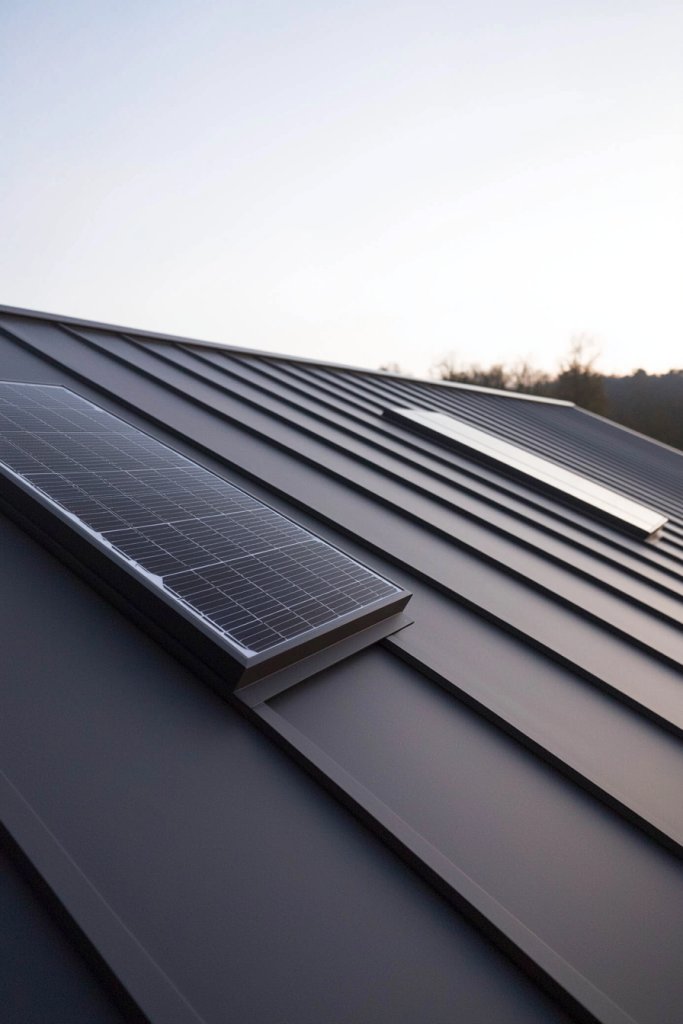
A clean, modern aesthetic is achieved by seamlessly integrating solar panels into the smooth lines of a minimalist roof, creating an elegant, uncluttered appearance that enhances curb appeal. This approach not only boosts energy efficiency but also elevates the overall architectural style of the home.
Imagine a roof with sharp, straight edges, painted in crisp, neutral tones like matte white or charcoal gray. The solar panels are flush-mounted, aligning perfectly with the roof surface so they appear as a natural extension rather than added components.
The panels themselves are sleek, with thin black frames and smooth, dark surfaces that reflect minimal light, blending effortlessly with the roof’s clean lines. The overall effect is a harmonious, contemporary silhouette that feels both sophisticated and unobtrusive, allowing the home’s architecture to shine without distraction.
To recreate this look, start by choosing low-profile, flush-mounted solar panels designed for minimalist aesthetics—many brands now offer models with ultra-slim profiles. Ensure your roof has a flat or gently sloped surface to facilitate seamless installation.
Work with a professional installer to precisely align the panels to match the roof’s lines, avoiding any protrusions or gaps. Using monochrome or dark-colored panels enhances the sleekness, and careful planning ensures they integrate perfectly, providing maximum energy while maintaining a modern, minimalist appearance.
2. Incorporate Solar Shingles for a Seamless, Tile-Like Roof Appearance
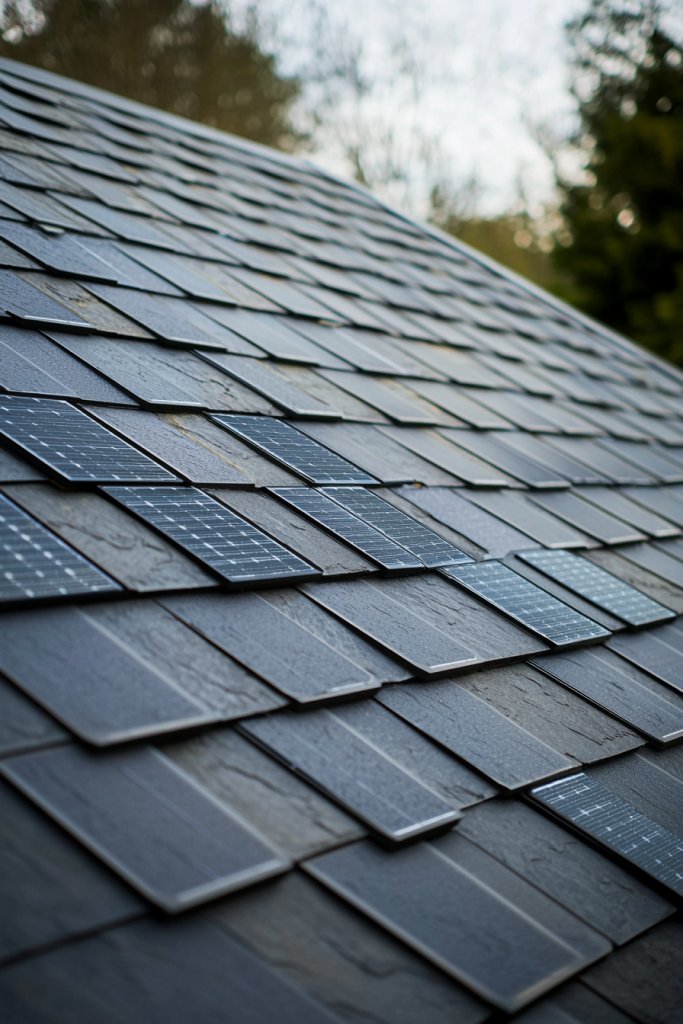
Solar shingles offer a sleek, uniform look for your roof by combining the protective qualities of traditional roofing tiles with the energy-generating power of solar technology. This integrated design creates a cohesive, elegant exterior that’s hard to distinguish from conventional shingles.
Picture a roof covered in rectangular, clay-colored or slate-gray shingles, each with embedded solar cells that mimic the appearance of traditional roofing material. The shingles interlock seamlessly, creating a smooth, continuous surface with minimal visible hardware.
The dark, textured surface of the solar shingles reflects subtle light, giving the roof a sophisticated, uniform look. The overall effect is a harmonious blend of form and function, where energy production is discreetly woven into the architecture.
To implement this idea, choose high-quality solar shingles compatible with your existing roof structure or consider a full reroofing project if replacing the entire roof. Work with a licensed contractor experienced in solar shingle installation to ensure proper sealing, waterproofing, and electrical connections.
Select a color palette that complements your home’s exterior—earth tones or dark hues work well for modern or traditional homes alike. With proper planning, solar shingles provide a seamless, visually appealing solution that combines energy efficiency with a refined, tile-like aesthetic.
3. Design Elevated Solar Panel Racks to Create Visual Interest and Shade
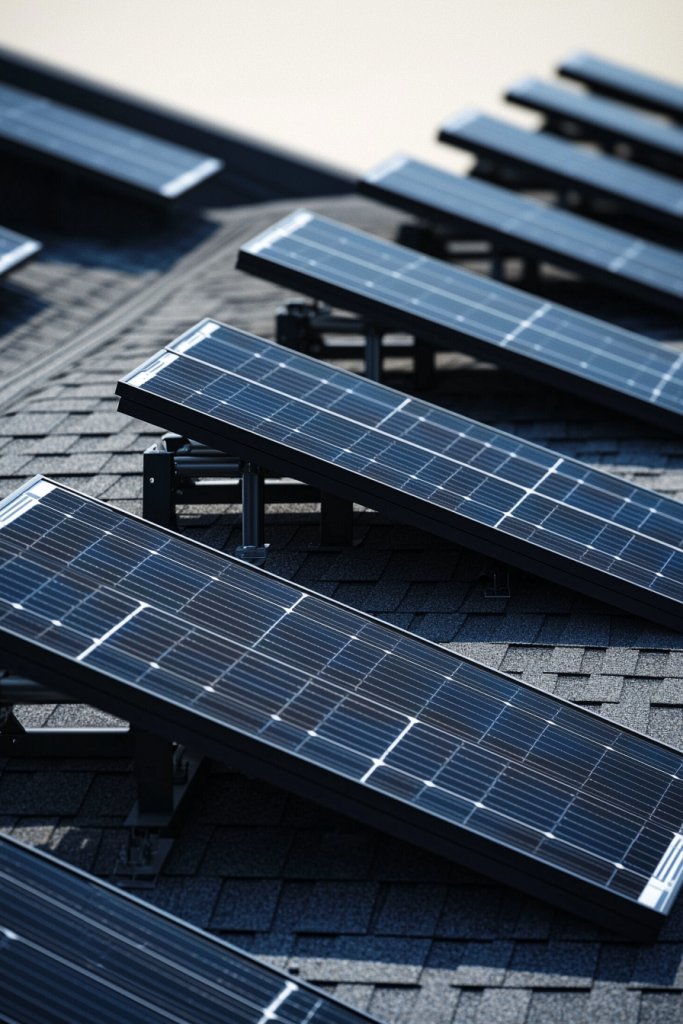
Elevated solar panel racks add dimension and visual intrigue to your roof while serving practical purposes like shading and airflow. By raising the panels above the roofline, you create a layered, dynamic look that combines functionality with architectural flair.
Visualize a series of sleek, metal racks standing a few inches above the roof surface, supporting solar panels that are angled to maximize sun exposure. These racks are painted in matte black or metallic finishes, contrasting beautifully with lighter roof materials.
The elevation creates shadows that dance across the roof during different times of the day, adding movement and depth. The space beneath the panels can also serve as a shaded walkway or sitting area, blending outdoor living with sustainable energy.
To implement this concept, start by selecting sturdy, weather-resistant racks designed for solar applications. Ensure they are adjustable to fine-tune the angle for maximum efficiency.
Mount the racks securely to your roof, making sure they do not compromise waterproofing or structural integrity. Choose panels with a sleek, modern look in dark or neutral tones. This elevated design not only boosts energy production but also introduces a bold, architectural element that elevates your entire roof aesthetic.
4. Combine Solar Panels with Reflective Roofing Materials to Boost Efficiency
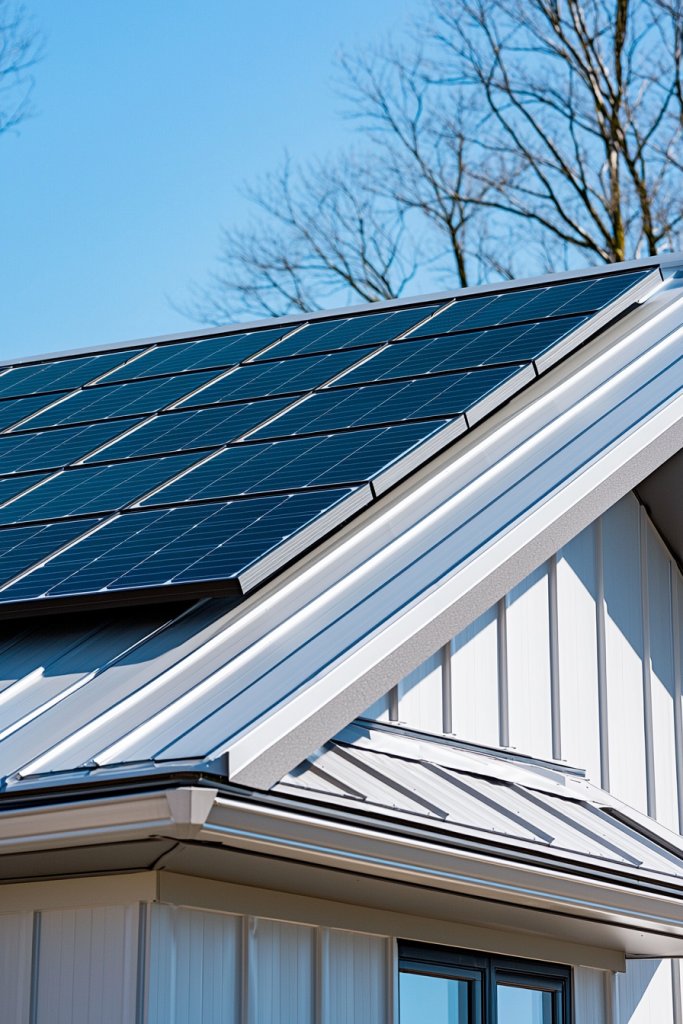
Pairing solar panels with reflective roofing materials enhances energy efficiency by reducing heat absorption, which helps keep your home cooler and improves solar panel performance. This combination results in a smart, eco-friendly roof that’s both functional and visually appealing.
Envision a roof clad in light-colored, reflective materials like cool gray or white metal panels, which bounce sunlight away and lower indoor temperatures. The solar panels sit flush against this luminous surface, their dark surfaces contrasting sharply against the bright roof, creating a striking visual effect.
The reflective roof not only enhances the panels’ efficiency by minimizing heat buildup but also gives your home a fresh, contemporary look. The combination exudes a high-tech, environmentally conscious vibe that’s perfect for modern homes.
To implement, select reflective roofing options such as metal panels coated with reflective paint or specialized reflective membranes compatible with solar panel mounting. Work with an experienced installer to ensure proper attachment and sealing.
Position the solar panels with optimal tilt and orientation to maximize sun exposure while benefitting from the reflective surface. This pairing provides a practical energy boost and a sleek, high-contrast aesthetic that emphasizes your commitment to sustainability and innovative design.
5. Install Solar Panel Canopies Over Porch or Patio Areas for Dual Functionality
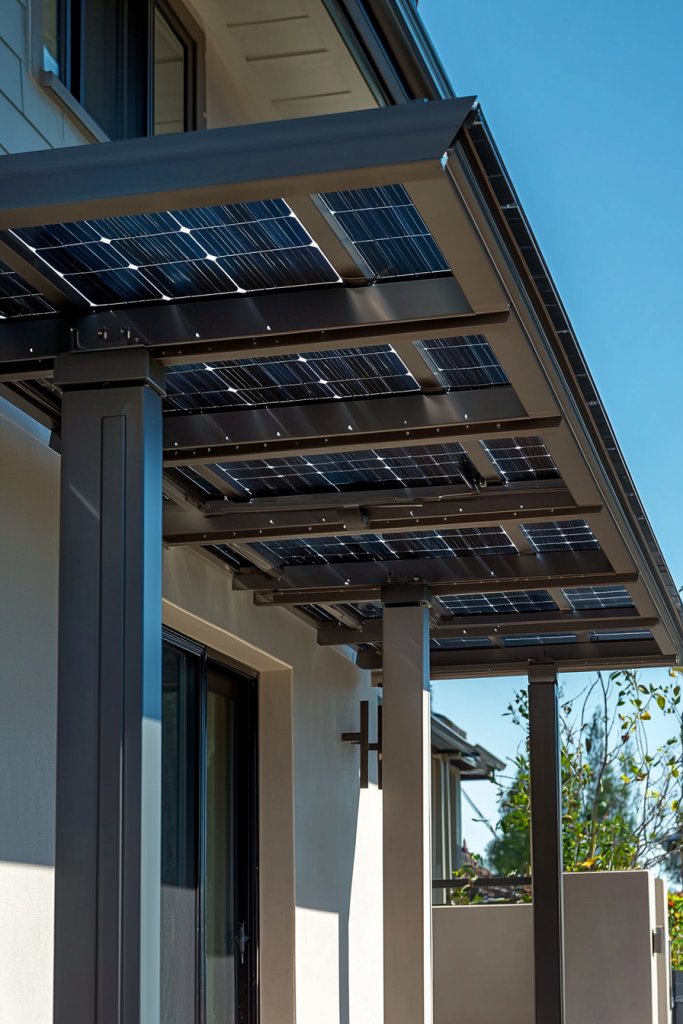
Adding solar panel canopies over porch or patio spaces transforms outdoor living areas into energy-generating zones while enhancing their usability. This approach not only provides shade and shelter from the sun and rain but also captures solar energy efficiently, making your home more sustainable.
It’s a smart way to combine practicality with eco-friendly design, perfect for those who love spending time outside. Imagine a sleek, modern canopy made of lightweight aluminum framing with solar panels integrated into the roof surface, casting a gentle dappled shade below.
The panels are tinted dark blue or black, blending seamlessly with the structure, while the beams are painted in neutral tones like matte gray or black for a contemporary look. The space underneath feels cool and inviting, with a subtle hum of energy conversion in the background, and the shadow patterns shift subtly throughout the day, creating a dynamic visual effect.
The area feels open yet cozy, perfect for outdoor dinners or relaxing with a book. To create this setup, start by measuring your porch or patio space and choosing solar panel modules that fit your area, considering adjustable mounts for optimal sun exposure.
Use aluminum or steel framing for durability and weather resistance, and secure the structure to existing support beams or posts. For a beginner-friendly project, opt for pre-made solar canopy kits available online, which typically include all necessary hardware.
Ensure proper wiring and connection to your home’s electrical system, or consult a professional if needed. Finish with weatherproof paint or coatings to prolong the lifespan of the structure.
6. Create a Patterned Arrangement of Solar Panels for Artistic Roof Designs
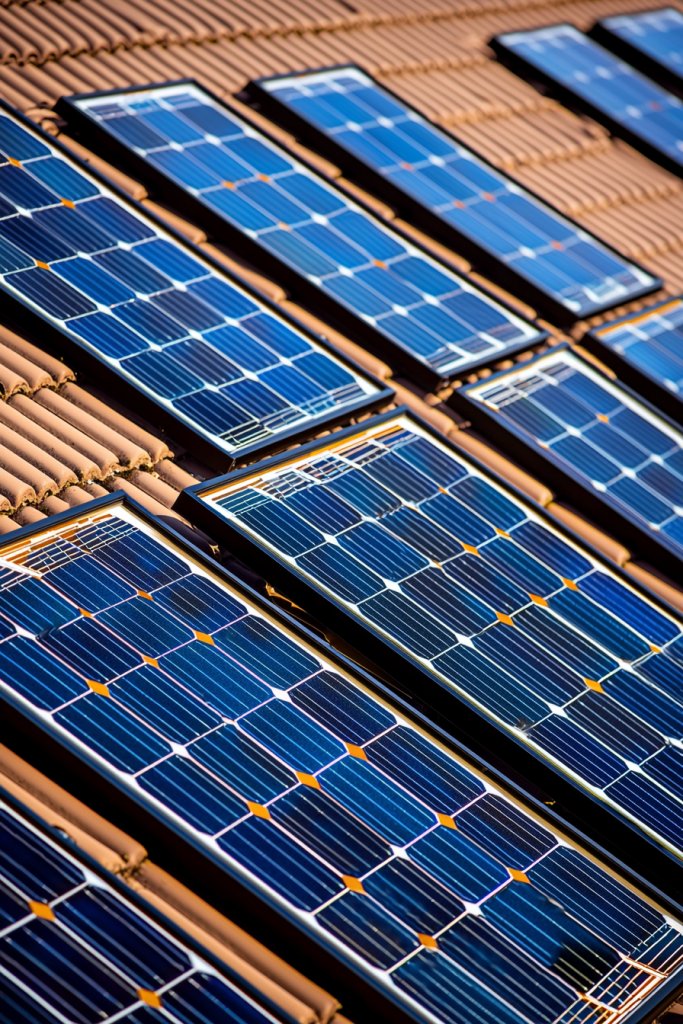
Designing a patterned layout of solar panels elevates functionality into an art form, turning your roof into a striking visual feature. This creative approach allows you to customize your solar installation, blending it with architectural elements or decorative motifs, making energy efficiency a true statement piece for your home.
Visualize a roof where solar panels are arranged in geometric patterns—perhaps alternating squares or triangles—creating a mosaic-like effect. The panels could be framed with sleek metal borders in contrasting colors like bronze or matte black, emphasizing the pattern.
The overall look might resemble a modern stained-glass mosaic, with panels carefully spaced to form a repeating design. When sunlight hits these patterned panels, they shimmer subtly, giving your roof a distinctive artistic character.
This arrangement balances high-tech functionality with a personalized aesthetic, making your home stand out. Getting started involves sketching your desired pattern on paper or using digital design tools, then translating that into your roof layout.
Select solar panel sizes that suit your pattern—standard rectangular modules are easiest to work with—and plan for consistent spacing. Use metal framing or decorative borders to enhance the visual effect, and consider color-tinted or framed panels for added contrast.
For ease, hire a professional to help with precise installation, especially if the pattern involves complex angles or multiple levels. This approach makes solar energy a conversation-starting feature rather than just a utility.
7. Design a Solar Panel Array with Integrated Ventilation to Improve Roof Cooling
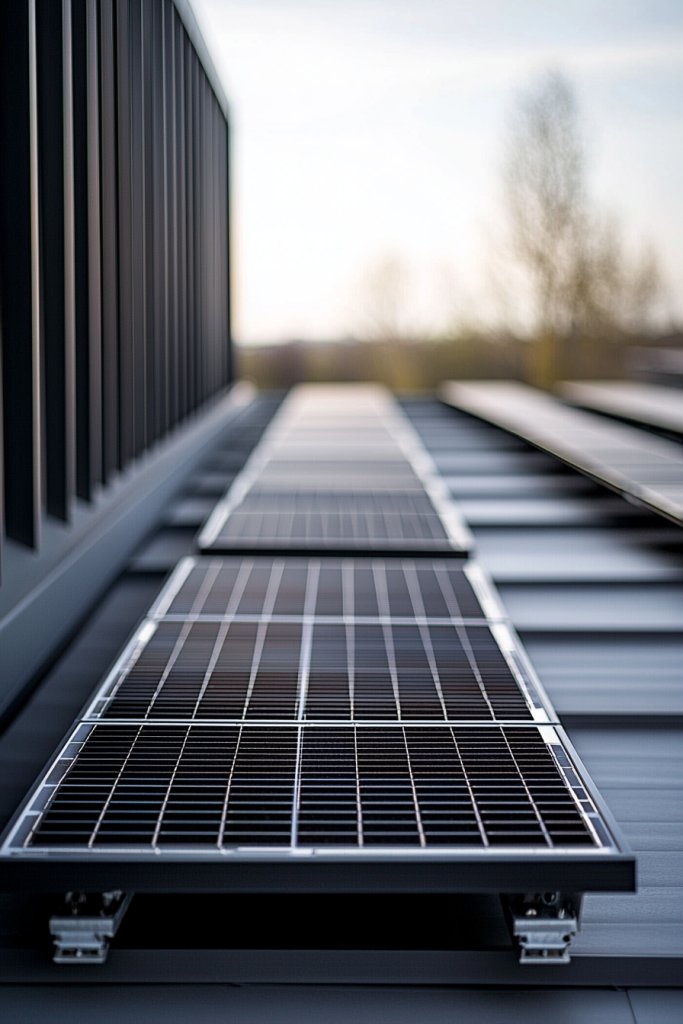
Creating a solar panel array with built-in ventilation not only boosts energy efficiency but also helps keep your roof cooler during hot months. This smart design involves incorporating vented gaps or soffits within the solar mounting system, allowing air to circulate underneath the panels.
The result is a more comfortable roof space and reduced heat transfer to your home, which can lower cooling costs. This approach marries functional engineering with sleek aesthetics, preventing the panels from looking bulky or obstructive.
Imagine a clean, modern rooftop with a series of slim, black solar panels arranged in a neat grid. Beneath these panels, a series of subtle vents or louvered openings encourage airflow, creating a gentle breeze that cools the entire assembly.
The space feels airy and open, with the panels sitting slightly elevated above the roof surface, allowing sunlight to bounce around, and the structural elements finished in neutral tones like matte gray or black for a contemporary look. The subtle movement of air adds a dynamic, almost organic quality to the roof’s visual appeal.
To implement this idea, start by choosing a solar mounting system designed for ventilation, or modify a standard rack with vented panels or louvered inserts. You’ll need solar mounting brackets, vented rails or panels, and possibly mesh screens to keep debris out.
Installing the vents involves attaching them between the mounting rails—this can often be done with basic tools and DIY-friendly hardware. Ensure proper sealing and secure fastening to withstand weather. If you’re unsure, consulting a solar professional can help customize the system for your specific roof type and climate.
8. Incorporate Solar Panels into a Sloped Roof with Visible Structural Beams for an Industrial Chic Look
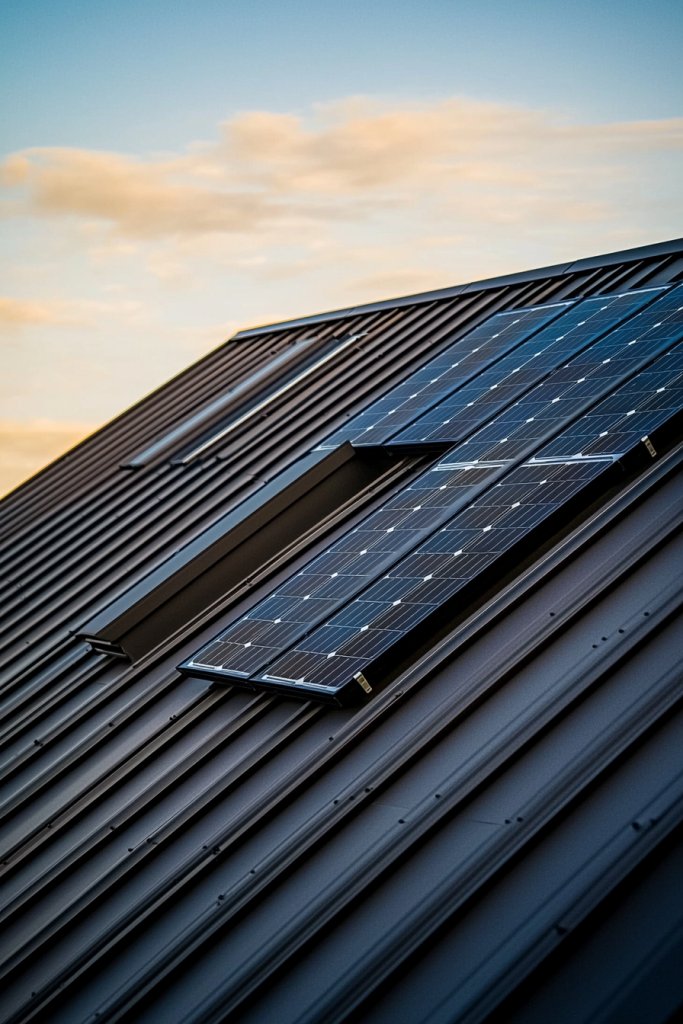
Integrating solar panels into a sloped roof with exposed structural beams creates an industrial aesthetic that’s both functional and stylish. This design showcases the raw beauty of the roof’s framework—think metal beams, rivets, and beams painted in matte black or galvanized silver—paired with sleek solar panels mounted directly onto the slope.
The combination emphasizes a rugged, utilitarian vibe, transforming the roof into a statement piece that blends modern energy tech with industrial charm. Picture a roof with a pronounced pitch, its dark metal beams crisscrossing against the sky.
The solar panels are mounted directly onto the sloped surface, aligning with the beams for a harmonious, geometric pattern. The overall palette features metallic tones—gunmetal, matte black, or brushed steel—complemented by the dark panels, creating a cohesive, edgy look.
The design feels bold, with an exposed, structural honesty that appeals to contemporary industrial interiors and exteriors alike. To implement, select solar modules with mounting hardware designed for sloped roofs—preferably adjustable brackets that align with the beams.
Use metal mounting rails that can be bolted directly to the beams for added stability and visual integration. Keep the wiring concealed within the beams or along the underside for a clean appearance.
This setup works best with metal or corrugated roofing that exposes structural elements naturally, making it perfect for modern industrial homes or converted loft spaces. It’s a striking look that combines utility with high-end architectural appeal.
9. Use Movable or Adjustable Solar Panel Mounts for Optimal Sun Exposure and Visual Flexibility
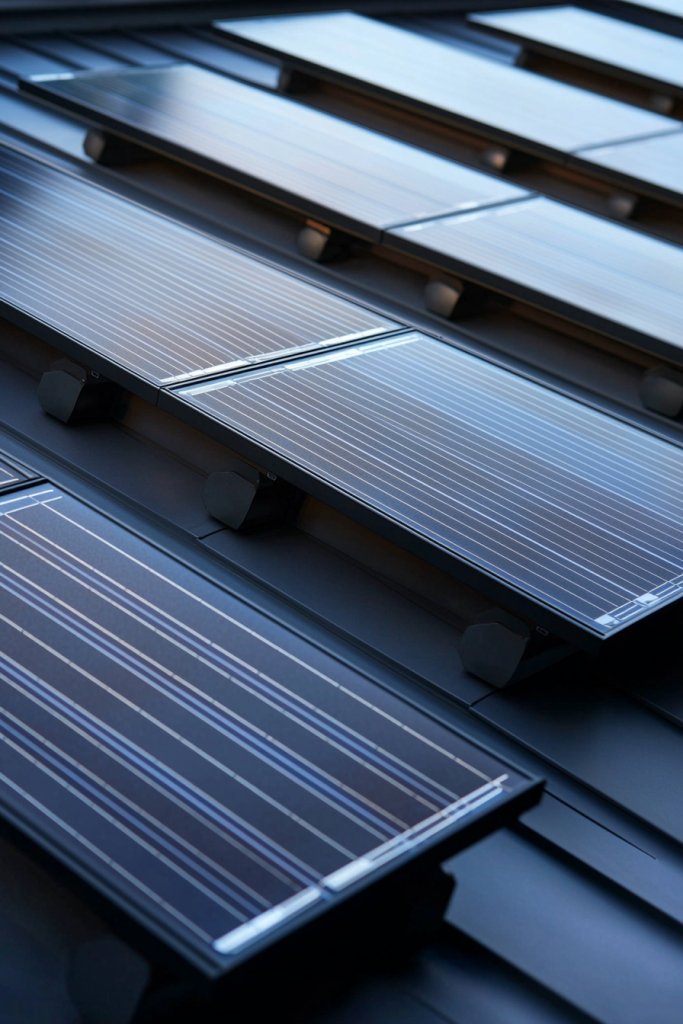
Installing movable or adjustable mounts for your solar panels offers the flexibility to optimize sun exposure throughout the year while adding a dynamic visual element to your roof. This approach allows you to tilt or rotate panels for maximum sunlight capture during different seasons, improving efficiency.
From a design perspective, adjustable mounts can also create interesting geometric patterns or layered effects, adding movement and visual interest to your roofscape. Imagine a roof where the solar panels are mounted on sleek, minimalistic arms that can pivot or slide.
During summer, you tilt the panels higher to catch the sun’s peak, then lower or angle them differently in winter to maximize efficiency. The adjustable mounts are often in black or metallic finishes that blend seamlessly with the panels, ensuring a sleek, modern appearance.
The ability to modify the panels’ position introduces a sense of activity, making the roof feel more interactive and innovative. To implement, choose adjustable mounting systems compatible with your solar panels—many are commercially available and user-friendly.
You’ll need pivot brackets, control arms, and locking mechanisms for stability. Basic tools and some DIY skills can be enough to install these systems, but consulting a solar expert can ensure proper alignment and safety. This setup allows for seasonal adjustments without major renovations, offering a personalized, flexible energy solution that also creates a futuristic visual statement.
10. Design a Solar Panel Array with Artistic Frame Borders for a Custom, Artistic Flair
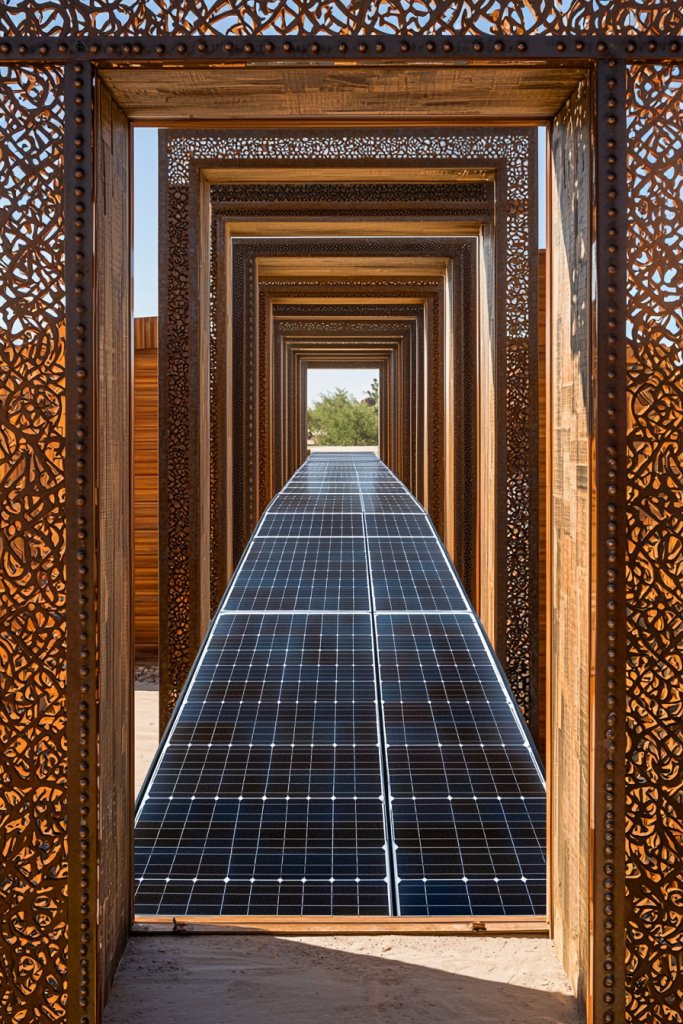
Adding artistic frame borders around your solar panel array elevates the design from purely functional to visually striking and personalized. This concept involves enclosing the panels within decorative frames made of materials like metal, wood, or composite, painted or finished in colors that complement your home’s exterior.
The frames can feature intricate patterns, geometric shapes, or simple clean lines, turning your solar installation into a piece of architectural art. Visualize a rooftop where the solar panels are outlined by a sleek, black metal border with decorative detailing—perhaps geometric cutouts or smooth curves.
The framing creates a visual boundary that draws the eye, highlighting the panels as a focal point. You might choose a frame with a matte or gloss finish in contrasting colors—such as brushed gold or matte black—to add depth and sophistication.
The overall effect is a harmonious blend of technology and art, giving your home a distinctive, curated look. To recreate this, select custom framing materials compatible with outdoor conditions, such as powder-coated metal or treated wood.
Attach the frames securely around the panels, ensuring they don’t interfere with ventilation or maintenance access. You can add decorative elements like engraved patterns or colorful accents for extra personality. This approach transforms a standard solar array into a bespoke design feature, making your roof both an energy source and a work of art.
11. Combine Solar Panels with Decorative Metal or Wooden Fascia for a Cohesive Exterior Style
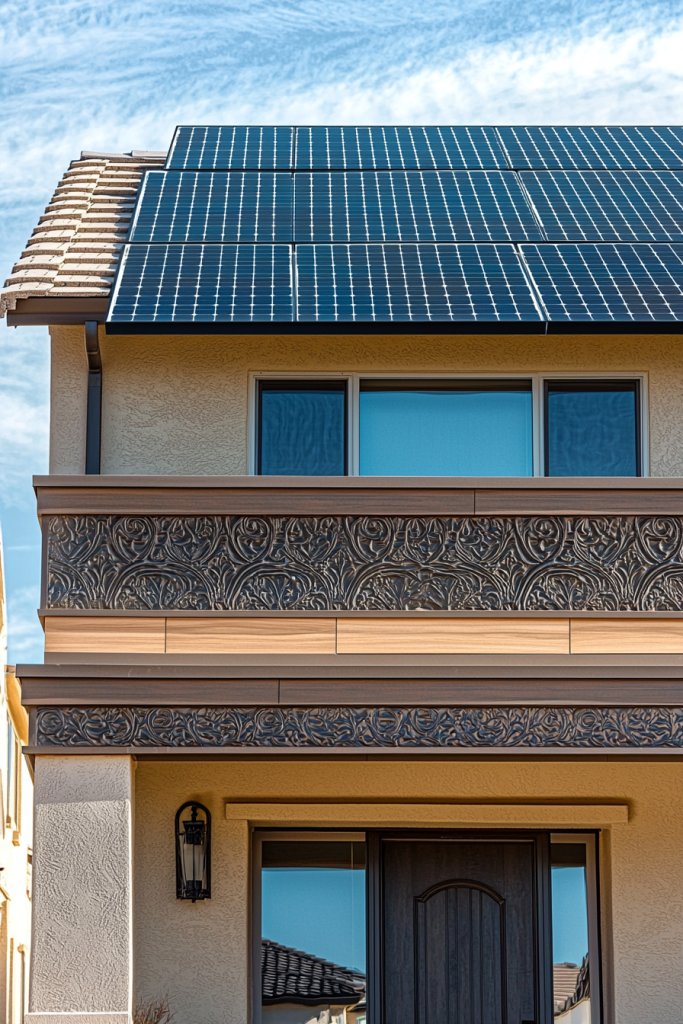
Blending solar panels with decorative fascia creates a unified, polished look that elevates your home’s exterior while maintaining energy efficiency. This approach ensures the solar elements complement your architectural style rather than standing out as an afterthought.
Visualize a charming farmhouse or contemporary home with a sleek, continuous fascia made of weathered wood or elegant metal panels in a muted color like charcoal or bronze. The solar panels are seamlessly integrated into this fascia, either hidden behind or flush-mounted within the decorative trim.
The result is a harmonious, layered facade where the solar array appears as a natural extension of the roofline, with clean lines and subtle textures. The combination of warm wooden fascia with the smooth, reflective surface of the solar panels adds visual interest and a sense of craftsmanship, creating a timeless, cohesive exterior aesthetic.
To achieve this look, start by selecting decorative fascia materials that match your home’s style—such as cedar, fiber cement, or metal panels. Mount the solar panels using low-profile, compatible brackets that allow them to sit flush within or behind the fascia, maintaining a sleek appearance.
Carefully plan the layout to ensure minimal visual disruption and optimal sun exposure. Seal all joints and edges to prevent water infiltration, and choose durable, weatherproof finishes for the fascia. If you’re unsure about integrating the panels into the fascia, consult a contractor experienced in custom facade design to ensure proper installation and aesthetics.
12. Incorporate Solar Panels into a Curved or Unconventional Roof Design for Unique Visual Appeal
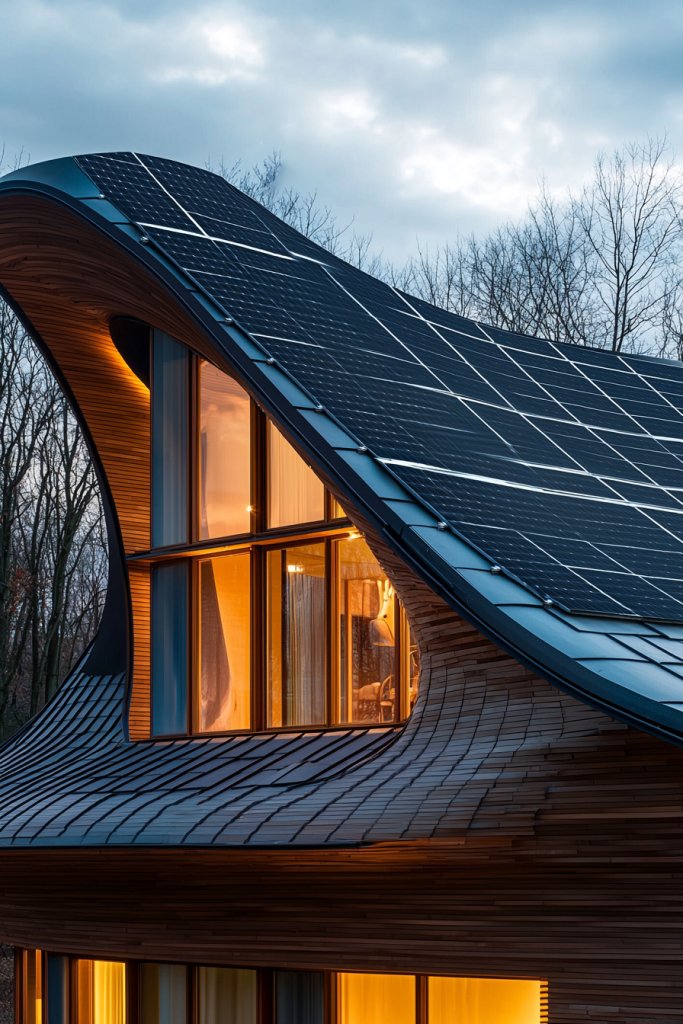
Integrating solar panels into curved or unconventional roof shapes transforms your home into a striking architectural statement while still capturing solar energy efficiently. This approach embraces creativity and personal style.
Imagine a modern residence with a sweeping, wave-like roof or a structure with asymmetrical angles. The solar panels are custom-cut or flexible, thin-film modules that conform to the curves, creating a seamless, flowing appearance.
The panels follow the roof’s contours, in shades of deep blue, black, or even semi-transparent, enhancing the dynamic form. The interplay of light, shadow, and reflective surfaces adds depth and visual intrigue, making the roof a sculptural centerpiece.
With thoughtful layout, this design balances artistic boldness with practicality, offering a truly distinctive home aesthetic that stands out and maximizes solar gain. To implement this, work with specialized flexible or thin-film solar panels that can bend to match curved surfaces.
Use custom-molded mounting brackets or adhesives designed for irregular geometries, ensuring secure attachment. Begin with detailed architectural plans that map out the curves and panel placement, consulting a structural engineer if necessary.
Ensure the roof’s material is compatible with the chosen mounting system and can support the added weight. Consider professional installation to handle the complexity of shaping and sealing the panels, and always prioritize safety and weatherproofing for long-term durability.
13. Design a Solar-Integrated Dormer or Skylight System to Maintain Aesthetic Harmony
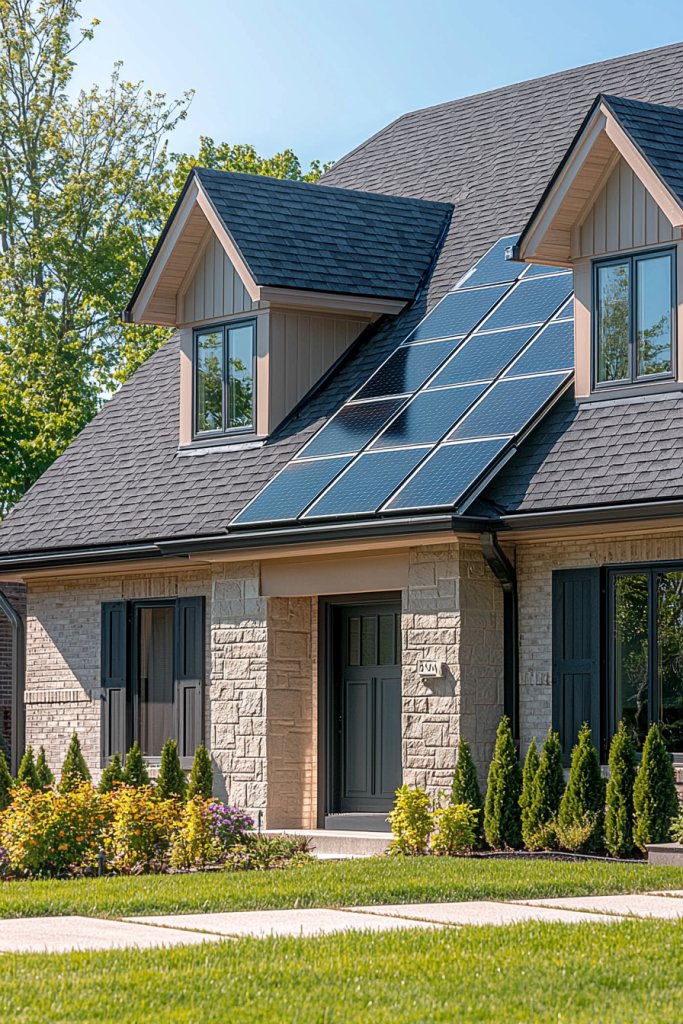
Incorporating solar technology into dormers or skylights allows natural light and solar power to coexist harmoniously, preserving your home’s aesthetic while boosting energy efficiency. This seamless integration elevates your roof’s design to a new level of sophistication.
Visualize a charming home with a traditional gabled roof, where solar panels are subtly incorporated into the dormer windows. The panels are designed as solar skylights or integrated modules that mimic the appearance of regular glass or window panes, with sleek, black frames.
The solar cells are either semi-transparent or coated with a dark tint to blend effortlessly into the roofline. When the sun hits, the panels glow faintly, adding a modern touch to the classic architecture.
The overall look is unified, with the solar elements enhancing the roof’s symmetry and charm, all while providing clean energy. To implement this idea, select solar skylight panels or dormer-integrated modules designed for aesthetic integration, available from specialized manufacturers.
Work with an architect or contractor to plan the placement, ensuring the solar elements align with existing rooflines and do not compromise waterproofing. Use weatherproof, UV-resistant framing materials like powder-coated aluminum or high-impact glass.
Install the units securely, seal all joints thoroughly, and connect the panels to your energy system. This approach offers a sleek, cohesive look that marries form and function with minimal visual disruption.
14. Use Solar Panel Arrays with Embedded LED Lighting to Enhance Nighttime Visual Impact
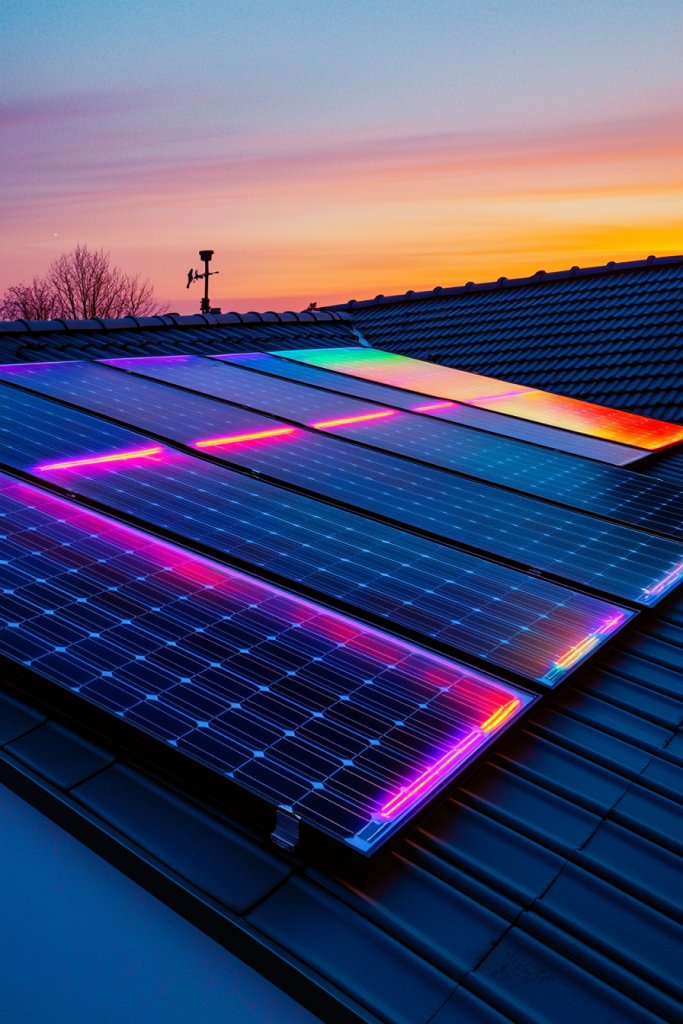
Adding embedded LED lighting within your solar panel arrays creates a stunning nighttime display, transforming your roof into an eye-catching feature that combines sustainability with visual artistry. This innovative lighting approach highlights your home’s eco-friendly commitment and adds a magical glow after sunset.
Imagine your solar array outlined with thin, waterproof LED strips integrated into the panel mounting frames or beneath the panels themselves. The lights emit a soft, warm glow that accentuates the sleek lines of your panels and creates luminous patterns across your roof.
You can choose colors or dynamic lighting effects to match your mood or special occasions. When illuminated at night, the panels seem to float against the dark sky, turning your roof into a captivating visual centerpiece.
To implement, select outdoor-rated LED strips designed for low-voltage, waterproof applications. Attach them securely along the edges or underneath the panels using weatherproof clips.
Connect to a solar-powered controller for energy efficiency, and program the lighting to switch on at dusk or for special events. With a simple setup and careful planning, this idea transforms your roof into a luminous work of art that celebrates sustainability and enhances nighttime curb appeal.
Conclusion
With a diverse array of design ideas—from sleek integrations and artistic arrangements to functional features like shading and ventilation—there are countless ways to maximize both the aesthetics and efficiency of your solar-powered roof. By experimenting with these innovative concepts, you can create a stunning, energy-smart home that reflects your style and values.
Don’t hesitate to bring these ideas to life and transform your roof into a powerful, beautiful energy-generating centerpiece. Start designing today and harness the sun’s potential for a brighter, greener future.
Leave a Reply